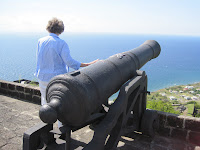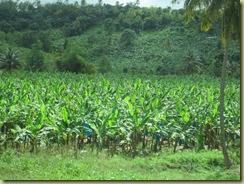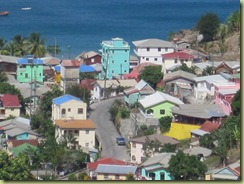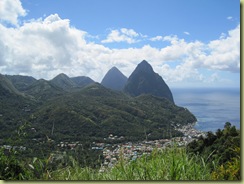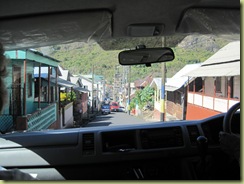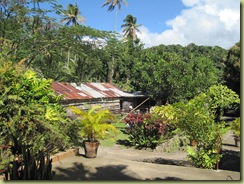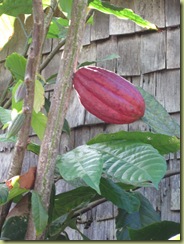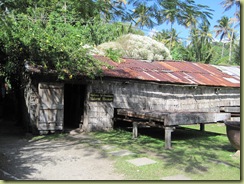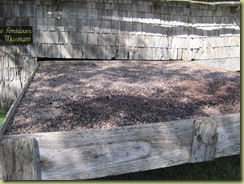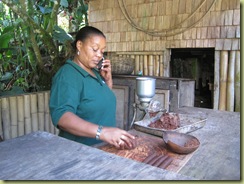Sunday, January 31, 2010
A tour of St. Kitts
We started off in the capitol city, Basseterre(where the Carnival was). The green clock tower is considered the center of the city. Independence Square is now a park but once was where slaves were auctioned. The big homes around the square housed in their basements the slaves waiting to be auctioned. The slaves were given their freedom in 1834. There is also a beautiful Co-Cathedral on this square as well as the current courthouse. We also stopped at the Anglican church in town.
We stopped briefly at some other sights and views. One place was a memorial to the war between the British and the Carib indians where it was said the Carib blood flowed from the battle field. We also stopped to see the nesting egrets. There were juvenile egrets in the tree waiting for their parent to bring them back food. They lofted high in the tree so the mangoose wouldn't get them.
Our first stop was at the Romney Manor, orignially owned by Thomas Jefferson's ancestors. It first was once a busy sugar cane plantation. It fell into disrepair post emancipation but in 1974 was purchased and repairs began. It now houses the Caribelle Batik business. There were many beautiful batiks displayed and for purchase. The manor also has lovely botanical gardens which are at the edge of the rainforest with Mt. Lumiagua nearby. The white flowered bush is named, "Snow on the Mountain."
We then travelled on north to the Brimstone Hill Fortress, a UNESCO national park. It was built by the English and the African slaves using the volcanic stones from nearby Mt. Liamuiga. The fortress is on a prominent hill on the northwest end of the island. It has beautiful views of the towns below, the Caribbean Sea and the island of Saba. On a clear day you can also see the island of Eustatius. Due to the volcanic eruption on Montserrat, the island south of Nevis, there was ash in the sky and we couldn't see Eustatius or St. Marten on the eastern side of St. Kitts. The British and the French had many battles to occupy the island of St. Kitts. The French ran a blockade off the coast of Brimstone Fortress and starved the British who finally surrendered. However, the French occupied the fort high on the hill for only one year before giving it back to the British! The stone gate leading into the fort complex is on a steep hill and a sharp turn - very difficult to maneuver vans and busses through! Click the link above for more info.
All along the route were small little villages. Some were fishing villages on the coast. We also saw goats everywhere! The goats go meandering off during the day to forage for food but know when to return home every evening. The villagers eat goat meat as a staple along with breadfruit, fruit (pineapple, papaya, mango, bananas) and garden vegetables. There are two schools in each village - the primary school for children to age 12 and then the secondary school from 12 to 18. The students in each school wear a school uniform. They looked very sharp! We enjoyed seeing the children walking home from school for lunch and after school.
We ate lunch at Rawlins Plantation on the northeast end of the island. It also had been a sugar plantation. We were the only ones there for lunch (we were late since we took longer to explore the fortress) and ate on the verranda. We ate a buffet of wonderful authentic Caribbean food: jerked chicken, curried chicken, johnny cakes,rice, sweet potatoes, pumpkin, tropical fruit, mango sauce...
We took two of the waitresses to their little villages after our lunch. At one village we could look out and see where the Caribbean Ocean met the Atlantic ocean. What a view.
What a wonderful day. Warm and humid, tropical and breezy, sunny and cloudy and full of great people and interesting sites!
Caribbean Chocolate
When we went to the Caribbean island of Saint Lucia on Jan. 14, 2010, we (I) really wanted to visit the Fond Doux Working Cocoa Plantation. I had, of course, read about it on the internet before our trip. But what I hadn’t read was that even though the distance wasn’t far from the port, the roads were very windy, two lane only and very slow! The trip was a good hour or more through the mountains and tropical rainforest and
past banana plantations and
small villages
with a beautiful overlook of the Grand Pitons peaks and into
the fishing town of Soufriere.
After checking out the volcano and sulphur springs, we headed in our van tour to the Fond Doux estate.
Whoever wrote the grand review for this estate, plantation and tour, ought to visit again!
But we still got to see two cocoa trees with the cocoa pods growing from newly green to ripe red. The other trees on the plantation are planted under the tree canopy to protect them – so the trees are just scattered here and there, not planted in rows.
The pods are collected, split open where the seeds (or cocoa beans) are covered in a milky film. The seeds are removed and washed and dried.
They showed us the washed and drying cocoa beans on large wooden trays. That was the tour!
Then off to the side, Mike discovered an employee who was grinding the beans. First grind broke the beans into smaller pieces and the second grind into a paste like dough. This was then rolled by hand into small logs. We each tasted the cocoa paste and it was bitter and chocolaty. I bought one of the logs she made with a recipe book. The St. Lucians like to drink Cocoa tea with grated cocoa from these logs. Still haven’t tried it out! Maybe today being a cool rainy day and I’m home with a cold would be a good time to give it a try!
Most of their chocolate is sold to Hershey’s in Pennsylvania.
Here is an album of our day in St. Lucia:
Saturday, January 30, 2010
How was the Caribbean Food?
We loved the Caribbean food we had. Our first night in St. Kitts we ate at the Marriott's Calypso Restaurant which features local fruits, vegetables and fish. We enjoyed their buffet with pumpkin, fish and chicken dishes, and seafood soups.
On Saturday morning, we found one grocery store open (all were closed for the holiday as Jan 2 is the last day of Carnival). Look at the frozen meat section pictures: ox tail, bull foot, pig foot, etc. The frozen beef and chicken didn't look like what we'd want to eat so we bought a ham to boil. We ate that ham almost every night that week.
We enjoyed a very authentic Caribbean buffet meal at the Rawlins Plantation on St. Kitts. We ate jerked chicken, fish, curry chicken, fritters, johnny-cakes, rice, salads, pumpkin, tropical fruit, and more. We ate sitting on the verrandah overlooking the plantation gardens, pool and smokestack.
Our guide told us that no one should ever have to go hungry on the island because food grows all year round. Many have breadfruit trees but these trees were pretty well picked by this time on St. Kitts (never saw one here with breadfruit). Breadfruit is a common food that they roast, boil and cook with stew (goat meat stews). Most every home has a small vegetable garden and many sell their vegetables at roadside stands. Also bananas grow well on the island. There are many coconut trees but apparently Kittitians don't use much coconut in their cooking (more so on other islands).
There are many fishing villages and the fishermen come back to the shore with their catch and sell it right on the roadsides. After seeing these "cutting" tables, I was ok not buying any fish to cook!
We tried conch fritters and Ting at the Shipwreck Cafe at So. Friar's Bay (where the monkeys were fed). The fritters were great and Ting is the island made grapefruit soft drink - it tasted good too. In Nevis we stopped at a bakery and bought a spice bun, a piece of chocolate cake (rather bread like), a cinnamon roll and something else. They were good, but not as sweet as we eat in the states. Bakeries were very small businesses with not much variety. They did sell pumpkin and sweet potato pies.
A great treat when we were hungry (well we were never hungry really) after our little rainforest hike on Dominica, was the ripe bananas, candied coconut, chopped coconut pieces, sugar cane and plantain chips! They were also selling coconuts chopped tops of with a machete and with a straw to drink the coconut liquid. (We all had tried that in Hawaii and none of us liked it then).
On our cruise port day back at St. Kitt's we went to see the Farmer's market but it was a Friday and not many were selling their fruits, vegetables or meats. I took lots of pictures on almost every island of the produce stands. The colors and sights were so intriguing. There were tiny green and red bell peppers (our driver said they were delicious), avocados the size of the small pineapples,ginger root, bananas, green onion bunches, actual yams as well as sweet potatoes, green pumpkins (insides were orange and pretty much tasted like pumpkin), onions, cauliflower, cabbages, and a green vegetable (can't remember the name).
One disappointment was that the cruise ship didn't have a special meal based on traditional Caribbean foods. We would have preferred that over the Mexican buffet served late one night. I should have added that to our comment card! However, I am anxious for Carmela to share a favorite recipe from her little cookbook from Nevis and I found a great sounding Jamaican ginger cake recipe I'll have to try!



















